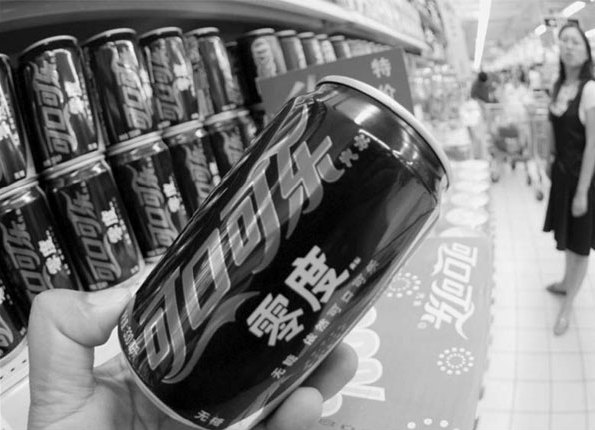Coke pushes low-sugar options
Updated: 2013-05-10 07:27
By Wang Zhuoqiong (China Daily)
|
||||||||
|
Cans of Coke Zero at a supermarket in Yichang, Hubei province. Liu Junfeng / For China Daily |
Move part of drinks giant's plan to boost availability of products
The Coca-Cola Company, the world's leading beverage maker, is expected to enhance the availability of low or no calorie beverages in China and continue to emphasize its marketing of carbonated drinks in second- and third-tier cities, a top executive said on Thursday.
Ahmet Bozer, president of Coca-Cola International, said customers in the central and western regions of China will have more opportunities to purchase Coke Zero and Coke Light beverages in addition to the drink's sugared version.
Bozer spoke after visiting the Xinjiang Uygur autonomous region in western China and Zhengzhou, Henan province, in the country's central region.
He said the low or no calorie beverages are part of the company's global pledge to help fight obesity in more than 200 countries by offering more choices and transparency to customers.
The commitments, which were announced on Wednesday, include offering low or no calorie beverage options in every market, supporting physical activity programs and not advertising to children under 12 years old.
Bozer said obesity is one of the most challenging health issues in the world.
Coca-Cola's efforts are a response to a trend in China that has seen healthy drinks take a larger share of the market, while that of carbonated beverages has decreased, according to an industry report last year.
The China Industrial Information Issuing Center report found carbonated beverages' market share reduced to 21.91 percent compared with water's 25.7 percent and juice's 22.24 percent. Carbonated beverages had a 36 percent share in 2000.
Coca-Cola's first quarter sales in China this year grew just 1 percent due to the bad weather and economic slowdown.
But the soft drink maker is pleased with the performance of its carbonated and juice categories, and considers the slowdown to be temporary, according to Bozer.
David Brooks, president of Coca-Cola Greater China and Korea, said it is important the company maintains its presence in these categories.
The carbonated product that takes up 60 percent of Coca-Cola's portfolio of beverages in China will continue to be the company's major growth driver, propelled by market potential in second- and third-tier cities as well as the countryside.
Sprite, a product of Coca-Cola, is the most distributed brand of any drink across all of villages and towns in China, said Brooks.
Between January and September 2012, Coca-Cola ranked No 1 in the carbonated beverage market, followed by PepsiCo and Mirinda, according to the report.
Sales from the Chinese market accounted for 8 percent of Coca-Cola's global businesses, or its No 3 market after the United States and Mexico.
To have their carbonated business available even in remote villages will put Coca-Cola in head-to-head competition with local brands, such as Master Kong of Tingyi Holdings Corp and Wahaha, which have cultivated stronger distribution channels in lower-tier cities.
Bozer said the company's "secret formula" is creating local partners, distribution systems and its own organization, so as to get the brand to consumers in a way that is relevant to them.
The "old product, new market" strategy will provide Coca-Cola a strong growth engine after it has reached market saturation in first-tier cities, said Gao Jianfeng, general manager at Shanghai-based Bogo Consultants.
Meanwhile, local beverage makers are competing more fiercely in first-tier cities with their newly developed tea drinks and water products.
"It is a battle at each other's main stronghold," Gao said.
wangzhuoqiong@chinadaily.com.cn
(China Daily 05/10/2013 page16)

 Michelle lays roses at site along Berlin Wall
Michelle lays roses at site along Berlin Wall
 Historic space lecture in Tiangong-1 commences
Historic space lecture in Tiangong-1 commences
 'Sopranos' Star James Gandolfini dead at 51
'Sopranos' Star James Gandolfini dead at 51
 UN: Number of refugees hits 18-year high
UN: Number of refugees hits 18-year high
 Slide: Jet exercises from aircraft carrier
Slide: Jet exercises from aircraft carrier
 Talks establish fishery hotline
Talks establish fishery hotline
 Foreign buyers eye Chinese drones
Foreign buyers eye Chinese drones
 UN chief hails China's peacekeepers
UN chief hails China's peacekeepers
Most Viewed
Editor's Picks

|

|

|

|

|

|
Today's Top News
Shenzhou X astronaut gives lecture today
US told to reassess duties on Chinese paper
Chinese seek greater share of satellite market
Russia rejects Obama's nuke cut proposal
US immigration bill sees Senate breakthrough
Brazilian cities revoke fare hikes
Moody's warns on China's local govt debt
Air quality in major cities drops in May
US Weekly

|

|








